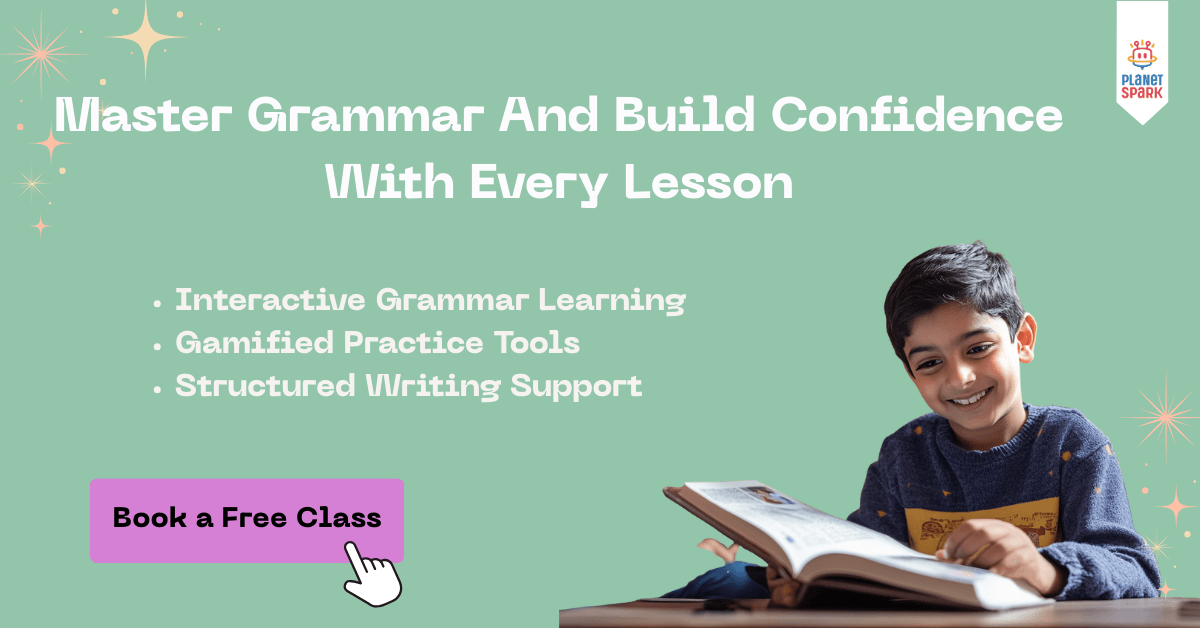Easiest Way to Teach Articles to a Class 4 Student

Table of Contents
- What are Articles?
- Types of Articles in English Grammar
- Rules for Using Articles (For Class 4 Students)
- Easiest Ways to Teach Articles to a Class 4 Student
- Common Mistakes with Articles (Class 4 Students)
- How PlanetSpark Helps Kids Master Articles
- Conclusion
- Readers Also Read
- FAQs on Teaching Articles to Class 4 Students
Articles are small but powerful words in English grammar. They may look simple, but they play a big role in making sentences meaningful and correct. For Class 4 students, learning how to use a, an, and the properly can feel confusing at first. Many kids either leave them out or place them in the wrong spot. That’s why teaching articles in a fun and easy way is so important.
When children master articles early, they not only write better sentences but also build a strong foundation for advanced grammar topics. Parents and teachers can make this learning journey exciting by using real-life examples, stories, and engaging article worksheets for Class 4.
This blog will guide you through the easiest ways to teach articles to a Class 4 student, with clear rules, examples, activities, worksheets, and common mistakes to avoid.
What are Articles?
Articles are special words in English grammar that help us talk about nouns clearly. They come before a noun and tell us whether we are speaking about something specific or general. In Class 4, students learn three main articles:
- A
- An
- The
A and An are called Indefinite Articles because they refer to something general, not specific.
- Example: I saw a bird on the tree. (any bird, not a particular one)
- Example: She ate an apple yesterday. (any apple, not a specific one)
The is called the Definite Article because it refers to something particular or unique.
- Example: The moon looks bright tonight. (only one moon, specific and unique)
Without articles, sentences sound incomplete or grammatically wrong. For example:
❌ I saw elephant.
✅ I saw an elephant.
By understanding articles, students can make their sentences smoother, clearer, and more meaningful.
Make Grammar Simple for Your Child!
Book a free demo class today and see how PlanetSpark makes articles easy with fun examples and activities.
Types of Articles in English Grammar
Articles are divided into two main types: Indefinite Articles (a, an) and Definite Article (the). Let’s break them down step by step for Class 4 students.
1. Indefinite Articles: A and An
Indefinite Articles are used when we talk about something general, not specific.
Rule 1: Use “A” before consonant sounds
- A cat is sleeping on the bed.
- He bought a ball from the market.
- I saw a rainbow in the sky.
Rule 2: Use “An” before vowel sounds (a, e, i, o, u)
- She ate an orange for breakfast.
- He is an intelligent boy.
- We saw an eagle flying high.
Note: It’s about the sound, not just the letter. For example:
- An hour (because “h” is silent and starts with a vowel sound)
- A university (because “u” sounds like “you,” a consonant sound)
2. Definite Article: The
“The” is used when we talk about something specific or unique.
Rule 1: Use “The” for unique things
The sun rises in the east.
The Taj Mahal is in Agra.
Rule 2: Use “The” for something already mentioned
I saw a dog. The dog was very friendly.
Rule 3: Use “The” before superlative adjectives
She is the best player in the team.
Mount Everest is the highest mountain.
Rule 4: Use “The” with names of rivers, seas, oceans, and mountain ranges
The Ganga is a holy river.
The Himalayas are covered with snow.
3. Zero Article (When No Article is Needed)
- Sometimes, we don’t use any article at all.
- Before names of people: Rahul is my best friend.
- Before names of subjects: Mathematics is difficult for some students.
Before plural nouns (when general): Dogs are loyal animals.
With these rules and examples, Class 4 students can easily start using articles correctly in daily conversations and writing.
Rules for Using Articles (For Class 4 Students)
To make learning easier, here are some golden rules children should remember while using a, an, and the:
Rule 1: “A” before words with consonant sounds
Use a when the noun begins with a consonant sound (b, c, d, f, g, etc.).
a ball, a dog, a car, a pencil
Rule 2: “An” before words with vowel sounds
Use an when the noun begins with a vowel sound (a, e, i, o, u).
an apple, an owl, an elephant, an idea
👉 Remember, it’s about the sound, not the letter!
an hour (silent “h”)
a university (“u” sounds like “you”)
Rule 3: “The” for unique or specific things
Use the when talking about something special, unique, or already known.
the sun, the moon, the Himalayas, the Ganga
I saw a bird. The bird was singing.
Rule 4: No article before names, subjects, and plural nouns
Names: Amit is my brother.
Subjects: English is fun to learn.
Plural nouns (general): Cats are playful animals.
Rule 5: “The” before superlatives and ordinals
the tallest building, the first prize, the best student
Rule 6: Repeat the article for different items
I need a pen and a notebook. (two separate things)
I need a pen and notebook. (may mean a pen with a notebook together)
By following these rules, students can confidently use articles in speaking and writing. Teachers can simplify this by turning each rule into a fun activity or worksheet exercise.
Turn Learning into Fun!
Join PlanetSpark’s free demo and experience how stories, games, and activities help children master articles without stress.
Easiest Ways to Teach Articles to a Class 4 Student
Teaching grammar doesn’t have to be boring! Articles (a, an, the) can be made fun and engaging if explained with activities, games, and real-life examples. Here’s a step-by-step approach teachers and parents can follow:
Step 1: Begin with Storytelling
Children love stories. Start with a simple story and highlight articles while reading aloud.
Example: Once upon a time, there was a boy who lived near the river. He had an old bicycle.
After reading, ask students to identify the words a, an, and the in the story.
Step 2: Use Visual Aids
Show flashcards with pictures of objects and ask students to use the correct article.
Picture of an apple → an apple
Picture of a dog → a dog
Picture of the sun → the sun
Step 3: Rule Reinforcement with Worksheets
Give students article worksheets for Class 4 where they fill in blanks with the right article.
Example: She saw ___ owl sitting on ___ tree.
Answer: an owl, a tree
Step 4: Group Activities
Divide the class into groups and conduct quick challenges like:
Article treasure hunt → Students find nouns around them and add correct articles.
Article relay → Teams complete sentences by racing to write the correct article first.
Step 5: Daily Conversation Practice
Encourage kids to use articles while speaking. For example:
Instead of saying “I saw elephant”, guide them to say “I saw an elephant”.
Correct them gently whenever they miss an article in daily conversation.
Step 6: Fun Games and Quizzes
Make learning interactive with:
Fill-in-the-blank games: Online or printed exercises.
Article Bingo: Call out a sentence, and students mark the correct article on their bingo sheet.
Spot the Mistake: Write incorrect sentences on the board and let students correct them.
Step 7: Reinforce with Reading and Writing
Encourage children to read storybooks and underline all the articles they find.
Ask them to write 5–10 sentences daily using a, an, and the.
Common Mistakes with Articles (Class 4 Students)
Even after learning the rules, children often make small errors while using articles. Here are some of the most common mistakes, along with their corrections:
1. Forgetting the Article
Incorrect: I saw elephant in the zoo.
Correct: I saw an elephant in the zoo.
2. Mixing Up “A” and “An”
Incorrect: She ate a orange.
Correct: She ate an orange.
Incorrect: He is an university student.
Correct: He is a university student. (because “u” sounds like “you”)
3. Using “The” Unnecessarily
Incorrect: The Mount Everest is the highest peak.
Correct: Mount Everest is the highest peak.
4. Missing “The” Before Unique Things
Incorrect: Sun is shining brightly.
Correct: The sun is shining brightly.
5. Wrong Use with Plural or Uncountable Nouns
Incorrect: The dogs are loyal animals. (when talking about dogs in general)
Correct: Dogs are loyal animals.
Incorrect: I need a water.
Correct: I need water. (uncountable, so no article)
6. Overusing Articles in General Statements
Incorrect: The honesty is the best policy.
Correct: Honesty is the best policy.
By pointing out these mistakes and practicing corrections through article worksheets for Class 4, teachers and parents can help children become more confident and accurate with grammar.
How PlanetSpark Helps Kids Master Articles
PlanetSpark makes grammar learning simple, fun, and effective for children. Instead of rote memorization, students engage in interactive methods that build long-term understanding. Here’s how PlanetSpark supports Class 4 students in mastering articles:
Interactive Grammar Lessons – Kids learn the rules of articles through real-life examples, storytelling, and engaging activities.
Personalized Worksheets – Each child practices with tailored article worksheets for Class 4, designed to strengthen weak areas.
Fun Games and Quizzes – Learning becomes enjoyable with grammar games, fill-in-the-blank activities, and quick challenges.
Expert Teachers – Experienced mentors ensure that children understand not just the rules but also how to apply them in everyday sentences.
Confidence in Communication – By practicing regularly, students develop the habit of using articles correctly in speaking and writing.
With PlanetSpark, children don’t just learn grammar, they gain the confidence to use it effectively in school and beyond.
Conclusion
Articles may be small words, but they play a big role in building clear and correct sentences. For Class 4 students, mastering the use of a, an, and the is a vital step in strengthening their grammar foundation. With simple rules, engaging activities, and regular practice using article worksheets for Class 4, children can quickly grasp the concept.
Parents and teachers can make this journey enjoyable through storytelling, games, and guided exercises. For extra support, platforms like PlanetSpark provide expert-led sessions and interactive resources that make learning grammar both effective and fun.
Strong grammar skills today lay the foundation for confident communication tomorrow.
Readers Also Read
Nouns for Class 4: Types, Examples, and Worksheet for Practice
Explore how identifying and using nouns boosts children’s ability to build clear and correct sentences. Great companion topic when learning articles for Class 4.Rules of Pronouns for Class 4 Students
Learn the essential rules of pronouns to avoid repetition and make writing smooth. Helps reinforce grammar concepts alongside articles.
FAQs on Teaching Articles to Class 4 Students
Q1. What are articles in English grammar?
Articles are words (a, an, the) used before nouns to indicate whether the noun is specific or general.
Q2. How do you explain articles to a Class 4 student?
Start with simple examples, like a dog, an apple, the sun, and gradually move to rules. Use stories, flashcards, and worksheets for easy understanding.
Q3. What is the easiest way to teach “a” and “an”?
Explain that “a” goes before consonant sounds (a cat, a ball) and “an” goes before vowel sounds (an egg, an idea). Reinforce with practice sentences.
Q4. When do we use “the”?
“The” is used before something specific or unique, like the moon, the Taj Mahal, or the first prize.
Q5. Can articles be taught through activities?
Yes. Games like Article Bingo, fill-in-the-blanks, and storytelling make learning fun and interactive for Class 4 students.
Q6. Why do children confuse “a” and “an”?
Children often look only at the letter and not the sound. Remind them that it depends on the sound—an hour but a university.
Q7. Are worksheets helpful in teaching articles?
Yes. Article worksheets for Class 4 provide structured practice, helping children avoid common mistakes and build accuracy.
Personalized Communication Report
Record a video to get a AI generated personalized communication report for your child

Hi There, want to try these
tips for your child with
LIVE with our expert coach?
Let's check your child's
English fluency

